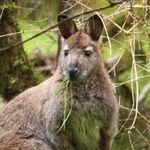Biosecurity Bites WINTER 2019 - Southern Issue - Environment Canterbury
←
→
Page content transcription
If your browser does not render page correctly, please read the page content below
Southern Issue
Biosecurity Bites
WINTER 2019
Wallaby co-ordination
Bennett’s wallabies have been increasing all wallaby habitat is controlled thoroughly
in numbers throughout South Canterbury using best practice methods to reduce the
since the Wallaby Board was disbanded risk of reinfestation.
in the early 1990s. Since then, recreational
Planning for Winter 2020 poison
hunting has been heavily relied on to
operations should already be underway
reduce wallaby numbers.
to ensure provision is made for stocking
This has become less effective over time; movements and bait manufacturing, role of wallaby co-ordinator to assist
land occupiers should now seriously as well as ensuring that neighbouring landowners who are co-ordinating control
consider larger scale poison operations properties have enough time to plan operations across multiple properties.
to reduce numbers across large areas. their control operations.
For more information on wallaby control
These operations must be co-ordinated
Environment Canterbury’s Biosecurity or co-ordination, please contact Jason on
with all neighbouring properties, ensuring
Officer Jason Hawker has taken on the jason.hawker@ecan.govt.nz or 027 228 2596.
Photo above: Wallaby
Photo above: Wallaby close upWhat's the Biosecurity Team been up to?
Here in South Canterbury we have the only known South Island site for
the pest plant bell heather. Each year we undertake control work at the
site and guide our efforts depending on how the previous year’s work went,
as well as plant numbers and distribution.
After engaging High Country Contracting to undertake most of the control
this year, a large area was successfully covered. A team of officers,
including some from Northern, finished up the edges of known hot spots,
and we made plans for future search and control, which will begin in the
next financial year. As we move into winter, our work with pests in our
progressive containment and sustained control programmes begins to
slow, although our animal monitoring is increasing. As a team, we are
taking the time to reflect on where we are at and lay down a strong work
plan for spring and summer.
Photo: Officer Lance Smith at the South Canterbury bell heather pest site
Out in the community
Something which we have all been putting a lot of effort into lately is
community engagement. Between us, we’ve attended a number of
community group meetings lately and it’s great to hear of all the initiatives
and work being done; we are grateful to be a part of it. One of our officers
recently spoke at Timaru Boys’ High School, where a small environmental
group is leading the way towards better care of the environment. Being
able to share stories and ideas is always positive, and it’ll be great to see
what they achieve both in the short and long-term.
Photo: Tim Gale (High Country Contracting), Jemma Hippolite and Debbie Eddington
(Environment Canterbury) with the Environmental group at Timaru Boys’ High School.
New officer joins the team
Environment Canterbury welcomes James Spence to the Southern
Biosecurity Team in Timaru. James replaces Sarah Davidson who
left in 2018.
James has worked at Environment Canterbury since Oct 2017 as
an advisory officer; as such, he has a good knowledge of most
workstreams within the organisation. Being born and bred in South
Canterbury, and passionate about the area and the environment,
he has chosen a biosecurity career to help prevent the spread of
invasive plants and animals.
Photo: James Spence.Helping out on the Chathams
For the past six years, staff from All but one crab was identified as a species
Environment Canterbury have gone to the known to the Chathams. The unknown crab
Chatham Islands to assist Kerri and Robin, was sent for identification.
the local biosecurity officers, with control
Debbie visited the Te One and Kaiangaroa
programmes on Chatham and Pitt Islands.
schools to talk to the pupils about the
Steve Palmer, the biosecurity advisor and
impact of pest species on marine and coastal
coordinator of the Chatham Island Pest
habitats. The children were very engaged
Management Strategy work, Terry Charles
and aware of the environmental challenges
and Jemma Hippolite (biosecurity officers),
regarding sustainability and waste.
and Debbie Eddington from the Youth
Engagement and Education Team made Earlier there had been a report of a
the trip in April. suspected rat incursion on Pitt Island –
very concerning given Pitt has always
Work included gorse control along roadsides
been rat free. Kerri has been training
using prills, follow up to the efforts of
with a Jack Russell named Moki specifically
previous years. Surveillance work focused
for rat detection since June 2018 and they
on marine pests. Crab pots were baited and
are now fully certified as a Conservation
set at the main port in Waitangi, Kaiangaroa
Dog Handler and Conservation Dog.
Wharf and boat harbour, and left overnight.
Fortunately, a day searching revealed no
An array of marine life including several
evidence of a rat being present.
crabs were retrieved from the pots.
Photo above: Red sandstone on the Chatham Islands
Photo inset 1: Steve and Jemma check a crab pot
Photo inset 2: Unidentified crab
Photo inset 3: Sand shark
Photo inset 4: Moki with a rat during a demonstration on Chatham IslandMETS 2019
Every year, the Canterbury/Westland branch of the New
Zealand Biosecurity Institute (NZBI) collaborate with
Environment Canterbury to present METS (Mini Educational
Training Seminars). This year the event was attended by
around 90 biodiversity and biosecurity professionals. On day
one we heard topics related to regional pest management,
community projects, research, innovations and pest control
projects. The depth of knowledge possessed by the speakers was evident. The level of
expertise demonstrated and shared among the attendees highlighted the growth of this field
and the important work happening in biosecurity and biodiversity throughout Canterbury.
On day two, 25 enthusiastic participants joined in a field trip around Christchurch and
the Port Hills, to see first-hand some new and emerging pest threats. The group visited
several locations and heard from a range of speakers about these pests and how these
Biosecurity are currently being managed. There was rigorous discussion among the group, which
Advisory Groups served as an opportunity to share collective experience. Overall, this was another
successful event. If you are interested in attending METS in the future or finding out
The process for reshaping the former more about NZBI, go to www.biosecurity.org.nz.
Pest Management Liaison Committees
and creating Biosecurity Advisory Groups Photo right: A drone pilot from Vector Charlie Charlie demonstrating their newest technology
continues. Motivated by a desire to during the METS fieldtrip
support the Biosecurity Programme
(in relation to both agricultural and
biodiversity pests) and provide a public
Exclusion pests – looking out for Noogoora bur
forum for pest management discussions, There are 11 pest plants in Canterbury’s Regional
it is proposed that there will be four Pest Management Plan that are not known to be
groups throughout the region, which in Canterbury, but which have the potential to
meet 2-3 times per year (open to the establish here and cause adverse effects on both
public) and are advisory in nature. production and environmental values. To see the
list, go to https://ecan.govt.nz and search for
Importantly, we want to ensure that
‘exclusion pests’. The aim of this programme is to
the new groups are made up of members
prevent these pests from establishing in Canterbury.
with a broad and balanced mix of
biosecurity interests and knowledge, One of these pests is Noogoora bur, Xanthium
strong community links that allow them strumarium. This plant is
to effectively champion biosecurity highly competitive and can cause significant losses
practices, and a solutions-based and in crops and displace pasture species. The seeds
future-focused approach. are poisonous to stock, particularly pigs and cattle, and the burs
easily contaminate wool reducing fleece quality.
There are currently a number of public
meetings taking place to discuss the new An annual herb Noogoora bur can be single stemmed and up to 2.5 metres tall or
structure of the groups and invite interest multi-stemmed and spreading depending on competition. Its leaves are dark green,
from the community. If you are keen to be sometimes mottled purple and similar to grape leaves in shape. The fruit are woody
involved or would like further info, go to burs covered in hooked spines, each bur containing two seeds and a single plant can
www.ecan.govt.nz/biosecuritychampions produce many hundreds of burs.
or email biosecurity@ecan.govt.nz.
The biosecurity team would like to hear from you if you have seen this plant in Canterbury.
Photo inset: Noogoora bur, Xanthium strumarium
E19/7267_3
For all pest enquiries, please contact the biosecurity team via
0800 324 636 or email biosecurity@ecan.govt.nzYou can also read
























































